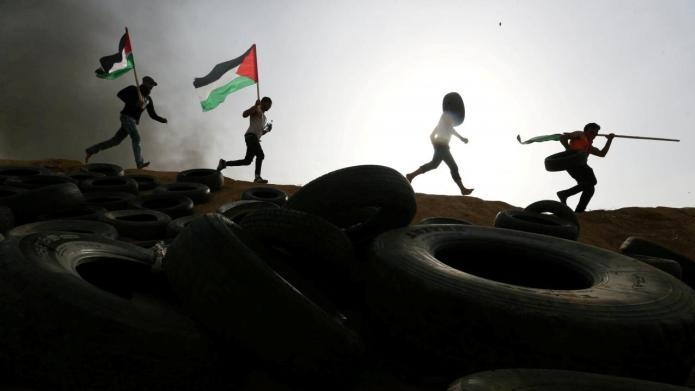


|
Palestinian protesters run during clashes with Israeli troops at Israel-Gaza
border, in the southern Gaza Strip on April 5, 2018. (Reuters)
Approximately 20,000 Palestinians participated in a rally in
five locations along the border between the eastern part of the Gaza Strip
and Israel. It was the second largest march in the six-week-long protest of
the Palestinians aimed at Israel, demanding fundamental and legitimate
rights, including the right to return to their homeland. The rally became
violent when the Palestinian demonstrators threw stones at the Israeli
soldiers, leading to clashes between the two sides. Nine Palestinians were
killed during the conflict, bringing the total number of Palestinian deaths
from the two weeks of frontier protests to nearly 30 and thousands of people
have been wounded.
The first day of the demonstration marked Palestine’s Land Day
as 42 years ago, the Israeli government ordered the expropriation of the land
in Galilee and Negev, resulting in large-scale protests by the Palestinians
in Israel. The current Palestinian marches are planned to last until the new
headquarters of the US Embassy in Israel is inaugurated in Jerusalem this May
14. The rally aims to demonstrate the Palestinians’ fierce opposition to US
President Donald Trump’s omission of Palestine’s territorial claims over
Jerusalem and his recognition of Jerusalem as the "capital of Israel”. The
eastern part of the holy sanctuary is considered by the Palestinians as the
capital of an independent Palestinian state in the future, therefore they are
willing to fight to the end for that purpose. The demonstrations are also due
to conclude on May 15 (Nakba or Catastrophe Day), marking the event in which
hundreds of thousands of Palestinians were expelled from their home during
the war between the Palestinians and the newly established Israeli State in
May 1948.
The Palestine Liberation Organisation (PLO)’s envoy to the US
Husam Zomlot criticised the US administration’s silence without any
"appropriate response” to Israel’s use of force aimed at the Palestinians. In
fact, Palestine has denied the mediate role of the US in the conflict since
President Trump recognised Jerusalem as the "capital of Israel”. The PLO has
warned that the tension in the Gaza Strip could possibly "explode” at any
time. Given the worsening developments in Gaza, Kuwait has continued to send
notifications urging the United Nations (UN) Security Council’s to promptly
intervene in order to stabilise the situation. The move took place as the UN
Security Council had earlier failed to reach a final statement on the
violence that has left many dead and injured in Gaza, because the
representative of the US, which has the right to veto at the UN Security
Council, rejected the draft statement.
The UN, the European Union (EU) and many countries in the region
have condemned the military actions of the Israeli forces against the
Palestinians and called on the two sides to restrain from further violence.
The violence in Gaza has also triggered a quarrel between Israel and Turkey.
The quarrel broke out after the Israeli Minister of Public Security announced
that the agreement on the normalisation of relations between Israel and
Turkey signed in 2016 might be a mistake. The Israeli officials condemned
Turkish President Recep Tayyip Erdogan as an "anti-Semite” after he
criticised Israel’s shooting dead of many Palestinian demonstrators. The
Turkish Foreign Ministry accused Israel of using "disproportionate forces”
against the Palestinians participating in "peaceful protests.”
The past few days have become the bloodiest period in the
Israel-Palestine conflict since the 2014 war. Violence in Gaza, if not
stopped, will continue to get worse and threaten the whole region.
|
Source: NDO